Thanks for joining me as I take another journey across London’s sights! This week I’ll take a short walk, but I’ll see a lot! My route begins at The Shard takes me through Borough Market and past Southwark Cathedral before taking a stroll across London Bridge and finally finishing at Monument.

My journey starts at the tallest building in the UK, The Shard. With 95 stories and standing at 309.6 metres (1,016ft) high, it’s also the fourth tallest building in Europe and the 105th tallest building in the world.
The Shard’s developer was Irvine Sellar, who had an ambitious vision to create an architecturally striking building that incorporated retail, offices, hotel, apartments, restaurants and a public viewing gallery. In November 1998 Sellar acquired Southwark Towers, occupied by PwC, and in May 2000 he arranged a lunch in Berlin with award-winning architect Renzo Piano.
Interestingly, Renzo said that he hated tall buildings! But he loved the energy of the railway lines at London Bridge and the Thames nearby. He sketched his vision of the building we see today, and The Shard was born! The inspiration of the design came from the spires of London churches and the masts of tall ships depicted by the 18th-century Venetian.

There were testing times for The Shard ahead due to the lengthy planning process, high-profile public inquiry, and investment problems as a result of the global economic crash. However, in 2008 the State of Qatar came on board with much needed investment.
The construction came under great challenges with sub-zero temperatures, gale force winds, and The Thames breaking through the protective dam. Nevertheless, in 2012 it was complete and opened by the Prime Minister of Qatar. Since then, its restaurants, hotel and viewing gallery have been opened to the public and tenants have begun to move into its offices.
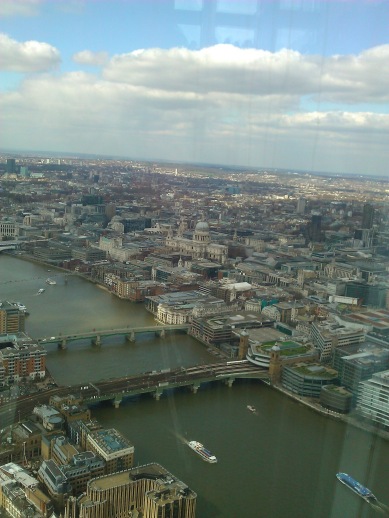
The Shard is located at London Bridge station, the oldest railway station in London fare zone 1, and one of the oldest in the world having opened in 1836. The station is the fourth busiest in the country with 56 million passengers travelling into it each year (many delayed!).
Currently, London Bridge is under a major construction project including a new bus station underway, station concourse, more entrances to the station, platform developments, and links to Crossrail. All this is due for completion in Spring 2018.
I leave the impressive Shard building and London Bridge station to take me on to Borough Market, London’s oldest food market which is over a 1,000 years old, having dated as far back as 1014.
Many of the Market’s stallholders are producers, from farmers to fisherman, with all the stalls, shops, and restaurants combining traditional British produce and regional specialities from across the world.
After a tasty trip to Borough Market I head to Southwark Cathedral which is the mother church of the Anglican Diocese of Southwark, and has been a place of Christian worship for more than 1,000 years. It has only been a cathedral since the creation of the diocese (a district under the pastoral care of a bishop in the Christian Church) of Southwark since 1905.
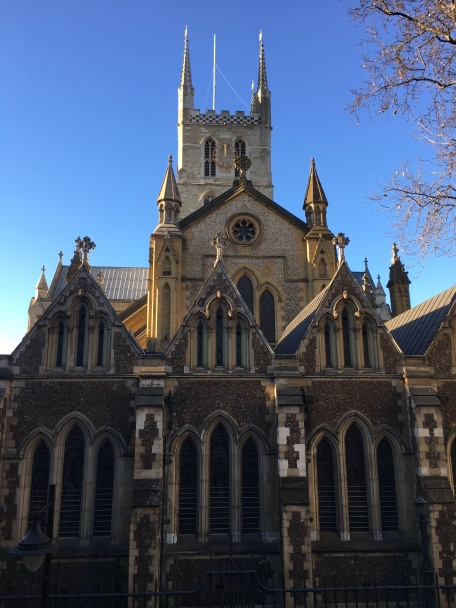
The current building has retained its Gothic structure that was built between 1220 and 1420. In 1539 it became the property of King Henry VIII who rented it out to the congregation, with being re-named St Saviour’s. However, in 1611 a group of merchants known as ‘the Bargainers’ bought it from King James I for £800, as they became tired of renting the church for worshiping.
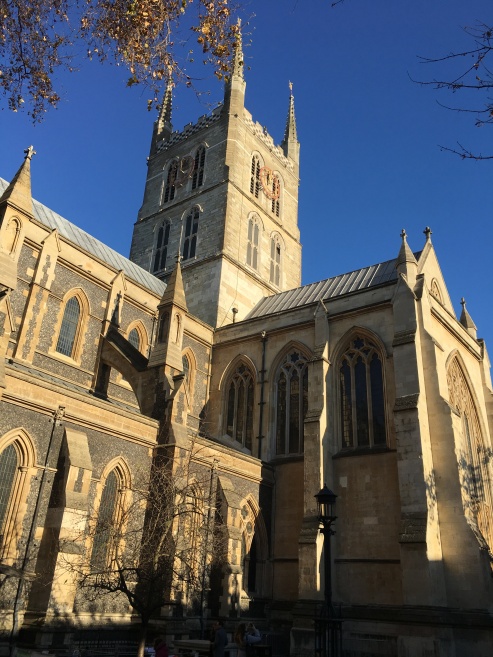
Throughout the 16th and 17th century many repairs were done to it, and by the 1820s is was threatened with demolishment due to proposals for a new London Bridge. Luckily, after much consultation, the building was restored, and it was thanks to architect George Gwilt that many of today’s parts are still there.
A new diocese was created with a new nave designed by Sir Arthur Blomfield in 1895 and by 1905 St Saviour’s church became Southwark Cathedral. The diocese has a population of two and a half million servicing over 300 parishes from Thamesmead in the east to Thames Ditton in the west.
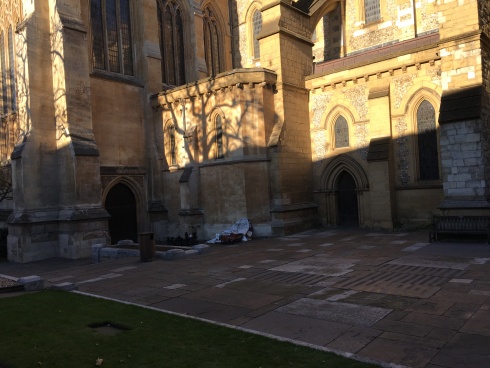
In 2000 major extensions, designed by Richard Griffiths, were added to the north of the Cathedral, adding meeting & conference rooms, a library, Education Centre, and a shop. Today, the cathedral holds five services a day all year round and is a centre of teaching, worship, prayers, and pilgrimage.
After embracing one element of heritage I move onto another, and to pretty much why this area is known as London Bridge! Before Medieval times, the only way to cross the Thames on the north bank to the southern suburb of Southwark was by ferry or a rickety wooden bridge… so both risky and not that convenient!
However, in 1176 after two successive wooden bridges were destroyed by fires, Henry II commissioned the building of a permanent stone crossing and after 33 years of construction, it was to last more than 600 years!
The finished bridge was 275m long with 20 gothic arches, and had a chapel, shops, and seven storey houses either side of it. Although the bridge was 8m wide, the buildings reduced the space for traffic to just 4m, making the journey still arduous which sometimes could take as long as an hour! Fire hazards were still prevalent with the worst coming in 1212 caused by sparks from a house, with at least 3,000 people dying.
In 1281, 1309, 1425 and 1437, several parts of the bridge collapsed. The 1281 collapse happened when expanding ice from the frozen Thames crushed five of the arches. These collapses were blamed on Queen Eleanor who was accused of misappropriating the bridges revenues and failing to repair them properly. Hence this is where the rhyme “London Bridge is falling down” comes from, as a dig at the Queen!
By the 18th century the old London Bridge, then over 600 years old, needed to be replaced with John Rennie winning the competition to design it (unconfirmed whether it was a process like The Apprentice or X Factor!). Rennie’s proposal was a five stone arch bridge 928 (283m) feet long and 49 feet (15m) wide. It started its development in 1824 and was completed in 1831 at a cost of £2.5 million (£205 million in 2015).
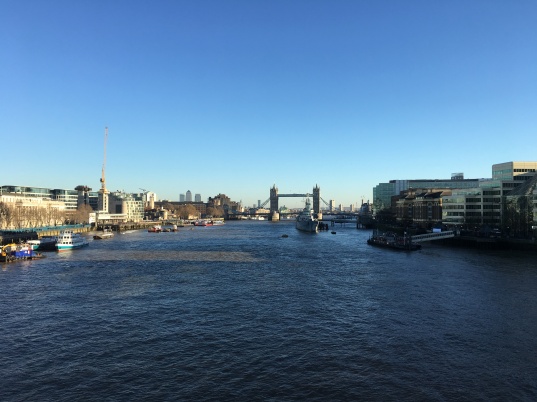
A walk a long the bridge takes me to our final stop today, Monument. The structure located at Monument Street and Fish Street Hill was built between 1671 and 1677 to commemorate the Great Fire of London, and to celebrate the rebuilding of the city. The fire which started in a baker’s house in Pudding Lane on Sunday 2nd September 1666 was finally extinguished on Wednesday 5th September. It destroyed most of the city with only stone buildings, St Paul’s and the Guildhall, surviving. Although it did help eradicate some of the black rats that carried the Bubonic Plague.

Sir Christopher Wren, the architect of St Paul’s Cathedral, and is colleague Dr Robert Hooke, provided the design of the Monument structure. The plans drew up contained 311 steps leading to the viewing platform surmounted by a drum and a copper urn to symbolise where the flames of the Great Fire came from. It is 61 metres high (202 feet), the exact distance between it and the site on Pudding Lane where the fire began.

On 4th October 1677, the Court of Alderman requested Dr Gale, a master of St Paul’s School, to devise a fitting inscription for the new pillars.
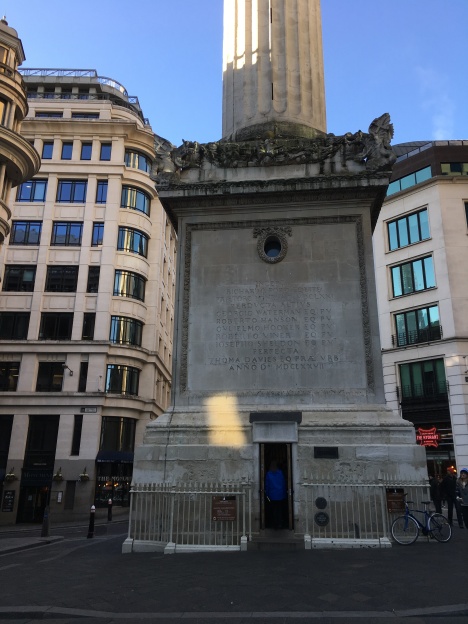
Three Latin inscriptions were devised covering the three panels. The north side records the City’s destruction, the south its restoration, and the east signifies the years and mayoralties in which the erection of the Monument was commenced. Also on the west is a sculptured design by Cibber.
So my journey has taken me from one end of London Bridge to the other where I’ve seen both impressive modern-day and older architecture. Hope you’ve enjoyed my short stroll, and stay tuned for another walking route next week!
Let me know your thoughts in the comments section below, and don’t forget to follow the blog and me on Twitter and Instagram 🙂
Sources: (not the food sauces)
All photos unless credit given London Wlogger © Copyright 2016











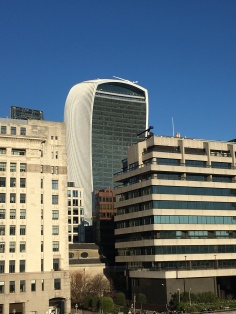




Love walking across town with you!
LikeLiked by 1 person
Thanks so much, Debbie! We love welcoming you on our London adventures too 🙂
LikeLike
Another enjoyable walk. Thank you very much.
LikeLiked by 1 person
Glad to hear, Brian! Although the walk is very short, about 10-15 minutes, you can see so much! 🙂
LikeLike
It might be a short walk but I reckon it would take us all day because we’d be stopping to look at/inside everything. We’ve been to the top of both The Shard and the Monument and the views are fantastic.
LikeLiked by 1 person
Haha you’re so right! I think this walk took me almost an hour as I was stopping taking lots of photos and embracing all of the areas splendour! The views across London are truly amazing, especially on a sunny day! 😊
LikeLike
We’ve been to most of this but I would love to look inside that cathedral.
LikeLiked by 1 person
The sculptures and designs in there, like most churches, will look amazing!
LikeLiked by 1 person
Another very interesting post, lots of great London trivia and views
LikeLiked by 1 person
Thanks Martin, glad to hear you’ve learnt more about our wonderful capital 😊
LikeLike
What a pleasure it was to walk with you! Thanks for a beautiful tour.
LikeLiked by 1 person
Thanks for joining us, Anne! 😊 Hope you can do the walk in real life soon!
LikeLike
Wishful thinking! We lived in Reigate from 1980 to 1982. I was in London only on Sundays when parking was easy.
LikeLiked by 1 person
So fascinating for one who began his working life in Lloyd’s ‘dome’ in 1960; regularly walked around these areas at lunchtime; and competed with a colleague in time trials running up and down the monument. 🙂
LikeLiked by 1 person
Haha that’s a great story, Derrick! Great use of the Monument 😜
LikeLiked by 1 person
This all looks very familiar to me!
JP
LikeLiked by 1 person
Awesome! Did you work around the area? Or have you done this lovely walk before? 😊
LikeLike
I live there!
JP
LikeLiked by 1 person
That must be amazing having all those incredible sights right on your doorstep! 😊
LikeLike
Ahh another great walk- thanks! Interesting info on the Shard…I wrote a post on The Shard a while back- but your description was far more elegant. Respect. Great post.
LikeLiked by 1 person
Haha thank you so much, Sam! Glad you enjoyed it 😊
LikeLiked by 1 person
Ahh welcome. I did! 😉
LikeLiked by 1 person
A good mix of facts and photos. I enjoyed walking with you. 🙂
LikeLiked by 1 person
Thank you! Don’t forget to follow for more walking adventures 😊
LikeLiked by 1 person
That was a lovely tour, thank you! I have been in London many times but the Shard post dates my visits.
LikeLiked by 1 person
Glad you enjoyed it, Kerry, thanks for joining me! 😊 It’s definitely a must see to get a breathtaking 360 degree view of our great capital! Stay tuned for more walks soon!
LikeLiked by 1 person
Bravo londonwlogger . Good article remind me of my trop to London
LikeLiked by 1 person
Awesome! What did you see when you were there? 😊
LikeLike
Trip
LikeLike
Nice work > Love that night shot with the bridge
LikeLiked by 1 person
Thanks Andy! Words can’t describe how majestic it looks!
LikeLiked by 1 person
There arent enough positive things said about the UK these days mate > keep up the good work
LikeLiked by 1 person
Great post and photos! Many thanks for stopping by and following my Travel and Photography blog. 🙂
LikeLiked by 1 person
Thank you! Hope you enjoy following my walking adventures 🙂
LikeLiked by 1 person
Indeed I will and hope you enjoy my travel adventures. Sty tuned for my post on being detained in Heathrow airport for 6 hours! 😉
LikeLiked by 1 person
A great walk, with so many excellent places to see along the way. I’d like to have a good looks at the Shard at some point, as well as the Monument and several other sites you mention. An interesting and informative post!
LikeLiked by 1 person
Thank you so much, Millie! 😊 You’ll get one of the best views imaginable from The Shard, it’s so stunning!
LikeLike
The Shard looks stunning n photos, which is the only way I’ve seen it, to date. The views from it alone make a visit a must. 🙂
LikeLiked by 1 person
It’s totally worth it, especially on a sunny day when you can see for miles! 😊
LikeLike
Magnificent landmarks and I love reading the historical background. I will definitely be back for more. Oh! and thank you for endowing me with the gift of an earworm – I’ll be singing “London Bridge is falling down” the rest of the day 😦
LikeLiked by 1 person
Haha, think I’ll be singing it all day now as well! 😜
LikeLiked by 1 person
I’ve done a similar walk:)
LikeLiked by 1 person
Wonderful history lesson and beautiful photos. Your research is outstanding.
LikeLiked by 1 person
Aww thank you so much, glad you enjoyed it! Don’t forget to subscribe to my podcast 😊
LikeLike
I hope to do a couple of your walks when I eventually can get to the UK.
My brother and his company built a lot of the Shard and I remember him telling me about all the problems with the glass. I’ve yet to venture up there.
LikeLiked by 1 person
Marvellous you’ll certainly love doing them! Wow that’s so cool, looked like an engineering miracle 😅
LikeLiked by 1 person